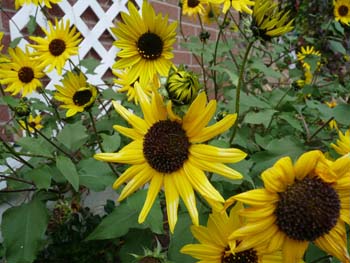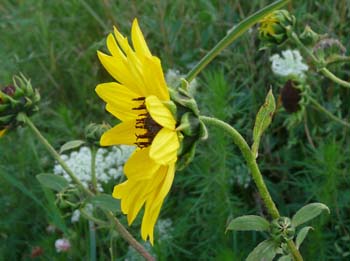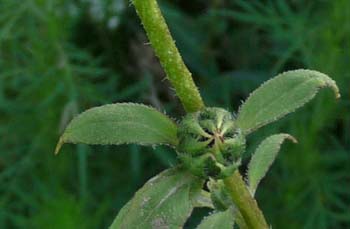





To support our efforts please browse our store (books with health benefits, etc.).
The wild sunflower is the non-cultivated cousin of the sunflower and it has showy ray petals which attract birds and butterflies. Interestingly, the leaves are phototropic; they turn to follow the sun therefore increasing the amount of light which leads to increased photosynthesis. This adaptation occurred because the sunflower’s primary source of nutrition is from conducting photosynthesis. The wild version of this plant is considered a noxious weed in many areas across Canada and in several U.S. states, and is native to North America (it was naturalized in Europe in the XVI century).
Distinguishing Features
Wild sunflowers are coarse, hairy, leafy, fast-growing annual plants that typically grow to a height of 1 to 1.5 metres high and have stiff upright stalks. The species is considered a weedy plant because it is commonly seen growing along roads, fences, fields and in waste areas. The flowers resemble the daisy and have a central disk of florets that have yellow ray florets surrounding them.
Flowers
The sunflower heads can measure up to 13 cm across and they have yellow, pleated rays and a red-brown central disk. The flower heads are daisy-like and they consist of numerous central disk florets that are yellow to brown; they are surrounded by approximately 20-40 ray florets. Flowers bloom between July and September.
 Fields
of Nutrition has medicinal benefits and vitamin/mineral content of Sunflower.
Fields
of Nutrition has medicinal benefits and vitamin/mineral content of Sunflower.
Leaves
Wild sunflower leaves have a rough, scratchy texture and are lance-ovate, egg-shaped, or heart-shaped, and can measure up to 30 cm long. The leaves are alternate and both the leaves and stems have course hairs. The upper surface of the leaves is dull green and covered with short stiff hairs, giving it a sandpaper-like feel. The petioles are light green to reddish green, and covered with short stiff hairs; the upper surface of each petiole is channeled.
Height
Wild sunflowers grow to an average height of between one and two metres.
Habitat
The wild sunflower habitat is primarily the prairies as well as dry, open areas. It grows along roadsides, in fields, along desert washes, and in grassy areas. It grows best in sunny, moist, or disturbed areas, and is tolerant of high and low temperatures (although more tolerant to low temperatures with the optimum temperature range being between 21 and 26 degrees Celsius). It thrives in alkaline soil and is somewhat drought resistant.
Edible Parts
The seeds are the typical edible sunflower seeds, but the wild seeds are very small, unlike the cultivated varieties used for commercial seed production. They can be consumed raw or cooked. (Seeds ripen from Sep to October.) Rich in fats, the seed can be ground into a powder and mixed with cereal flours to make nutritious bread. Seeds can be used for spouting and eaten as soon as they sprout. Young flower buds can be steamed and served like globe artichokes. The leaf petioles can be boiled and mixed in with other vegetables. Flower petals, leaves and roots can be used to make tea.
Other Name
Wild Sunflower.
Similar Plants
Winter Survival Food Handbook

PDF Plant Magazines
Types of Wild Food
Geographic Zones Seasons
Disclaimer
EdibleWildFood.com is informational in nature. While we strive to be 100% accurate, it is solely up to the reader to ensure proper plant identification. Some wild plants are poisonous or can have serious adverse health effects.
We are not health professionals, medical doctors, nor are we nutritionists. It is up to the reader to verify nutritional information and health benefits with qualified professionals for all edible plants listed in this web site. Please click here for more information.
Why Edible Wild Food?
- Food costs are rising
- Free, wild food is readily abundant
- Wild food adds nutrition to your diet
- Wild food can help treat various medical conditions





